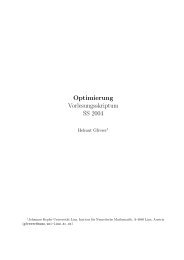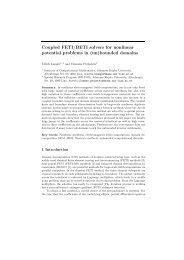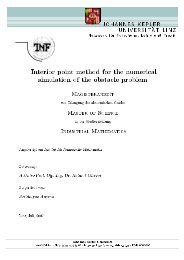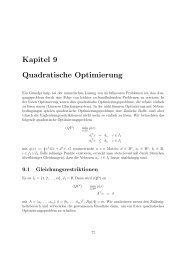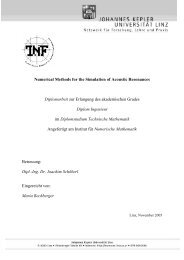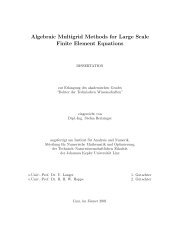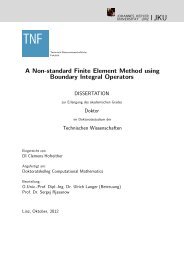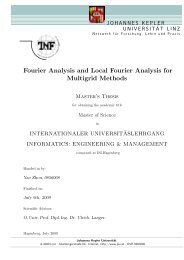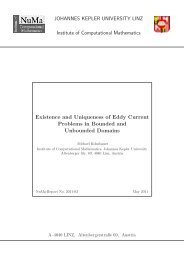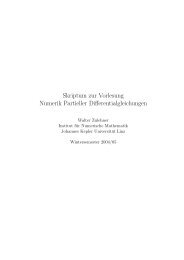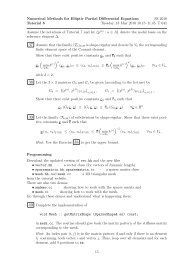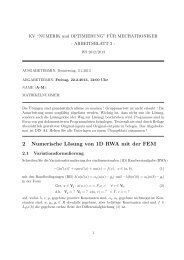PDF file - Johannes Kepler University, Linz - JKU
PDF file - Johannes Kepler University, Linz - JKU
PDF file - Johannes Kepler University, Linz - JKU
Create successful ePaper yourself
Turn your PDF publications into a flip-book with our unique Google optimized e-Paper software.
CHAPTER 2. PRELIMINARIES 20<br />
element we get<br />
‖u − u h ‖ 1 + ‖p − p h ‖ 0 ≤ Ch t (|u| t+1 + |p| t ), for t = 1 or t = 2,<br />
if (u, p) ∈ H t+1 (G) d × H t (G). For the modified element, only the estimate with t = 1<br />
remains true.<br />
2.2.1.2 Stabilized P 1 -P 1 Element<br />
If we use piecewise linear basis functions for both pressure and velocity components (Figure<br />
2.2(b)) we obtain an element which is very easy to implement in a concrete computer<br />
program but unfortunately does not fulfill the discrete inf-sup condition. As mentioned<br />
in Remark 2.5, numerical solutions computed using this element often contain unphysical<br />
pressure modes which prevent convergence against the solution of the continuous problem.<br />
A possible way out is the introduction of the following stabilizing c(., .) term in (2.15)<br />
∑<br />
c(p, q) = α S h 2 τ i<br />
(∇p, ∇q) 0,τi , (2.22)<br />
i<br />
and a right hand side term to preserve consistency<br />
∑<br />
〈G, q〉 = −α S h 2 τ i<br />
(f, ∇q) 0,τi , (2.23)<br />
i<br />
where α S is a positive parameter (intensive discussion on the correct choice of this parameter<br />
and the local mesh size h τi can be found for example in [Bec95] or [FM93]). We will<br />
refer to this stabilized element as P 1 -P 1 -stab.<br />
Remark 2.6. Another possibility of stabilizing the P 1 -P 1 element leads to the so called MINIelement.<br />
Here the velocity space is extended by bubble functions, i.e. u h is an element of<br />
Ũ h with<br />
Ũ h := {v ∈ U : v| τi = w| τi + b τi ᾱ τi with w ∈ U h and ᾱ τi ∈ R d },<br />
where b τi (x) = ∏ j λ j(x), and λ j (x) are the barycentric coordinates of x with respect to τ i .<br />
It is possible to locally eliminate the bubble-variables, which leads to a similar problem as<br />
(2.15),(2.22),(2.23), with slightly more information on the choice of α S , e.g. that it should<br />
be of order O(1/ν).<br />
Although this element does not fulfill the inf-sup condition, the following result holds<br />
(without proof)<br />
Theorem 2.7. [FS91, theorem 3.1] Suppose that the solution of the continuous Stokes problem<br />
satisfies u ∈ H 2 (G) d and p ∈ H 2 (G). Then for α S > 0 the problem (2.15),(2.22),(2.23)<br />
has a unique solution, satisfying<br />
‖u − u h ‖ 1 + ‖p − p h ‖ 0 ≤ C(h|u| 2 + h 2 |p| 2 ). (2.24)



